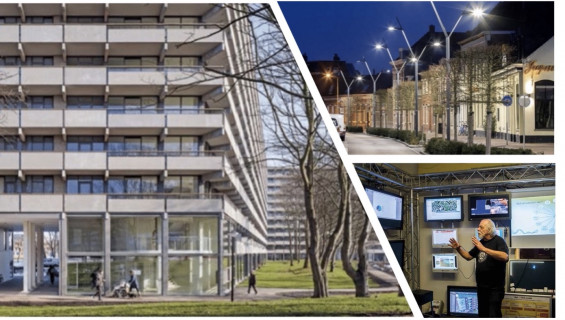This is the 13th episode of a series 25 building blocks to create better streets, neighbourhoods, and cities. This post discusses the way cities can secure public space, distinguishing symptom control and a more fundamental approach.
Scope of crime
According to the World Health Organization, the risk of being confronted with physical violence significantly detracts from the quality of life. In 2000, homicides worldwide resulted in half a million deaths, nearly twice the number of people who died in a war that year, but less than 40% of fatalities on roads. Many murders are related to drug trafficking. The number of murders in the European Union that year was about 5200. Between 2008 and 2016, car thefts dropped by 36% and robberies by 24%. Both trends leveled off after 2010. However, police-recorded sexual violence in the EU shows an increase of 26% between 2013 and 2016.
Monitoring
Social safety is a precondition for the viability of public space. This applies to who works there, who lives there and who visits it. Frequently chosen solutions are the installation of cameras. Not bad, although streets without cameras run the risk of becoming less safe. Moreover, miscreants know well how to disguise their identity.
In Stratumseind, the illustrious nightlife center of Eindhoven, extensive experiments with CCTV cameras and sensors and, in addition, atmospheric lighting and scents have been executed (photo below right researcher Rinus Kanters in the control room). The city regards this experiment as a 'living lab' and it has continuously been evaluated. The results so far are that no clear connection has been found between this technology and the number of incidents, the feeling of safety among visitors has increased and the police are more quickly on the scene in the event of incidents.
Intensive use
Further conditions are intensive use. The more people on the street, the greater the social security, except for theft. Also 'eyes on the street', apartments in the space above the plinths help. More generally, transparency is of value. Transparent plinths of apartment buildings contribute to it (photo left: the Kleiburgflat, Amsterdam)
Lighting
Lighting is an important issue. It is not even so much about the fierceness of it, which entails other objections, but about the uniformity (photo above right). A particularly wrong idea is to equip lights with motion sensors, so that they only come on when a passer-by approaches. This is at the expense of the ability to keep an overview. There is no objection to slightly dimming the lighting when streets are less busy.
A decent existence
The ultimate policy to reduce crime and improve security is:
• Providing training, guidance and 'social employment', such as the 'Melkert jobs' from the 1990s, to bridge the distance to the labor market.
• Creating guaranteed jobs in the public sector for all. Not only to improve the quality of life of the unemployed, but also to perform numerous tasks that are currently left undone.
• Allocating a decent income to all adults, as long as paid work still falls short. Experiments with basic income show that this increases resilience, self-confidence and the chance of paid work.
• Providing temporary professional (psychological) assistance and guidance with household, and financial management and training on the way to full integration in society.
• The more intensively residents of a neighborhood interact with each other and keep an eye on each other's possessions, the less crime will have a chance. Social control has always been a powerful weapon against crime.
• In anticipation of permanent housing, shelter the homeless to prevent drug-related crimes and give high priority to combating violence and burglary.
It would be naive to think that less inequality and improvements in income, jobs and housing for the poorest groups will eliminate crime altogether. Greed, thrill-seeking, boredom, membership in wrong groups, wrong connections, imitation, mental illness, and alcohol and drugs abuse are not necessarily related to poverty and require judicial action.
Effective prevention and policing
• protection against the relatively small group of repeat-offenders, who are responsible for most crimes, especially violent crimes.
• Close cooperation between residents and the police at neighborhood level
• Police presence on bicycles (better than in cars),
• Detailed knowledge of the police and judiciary of and communication with youth groups that incidentally causes problems
• Sensible and proportionate use of digital resources to track down criminals.
Follow the link below to find an overview of all articles.





